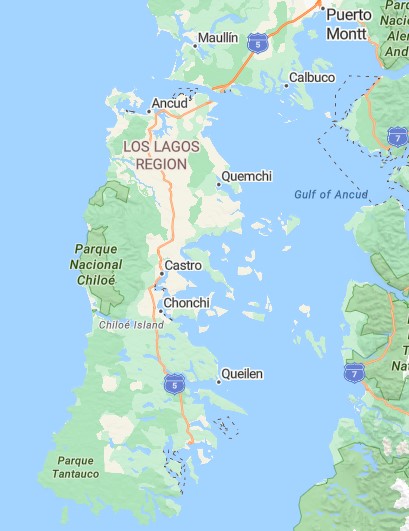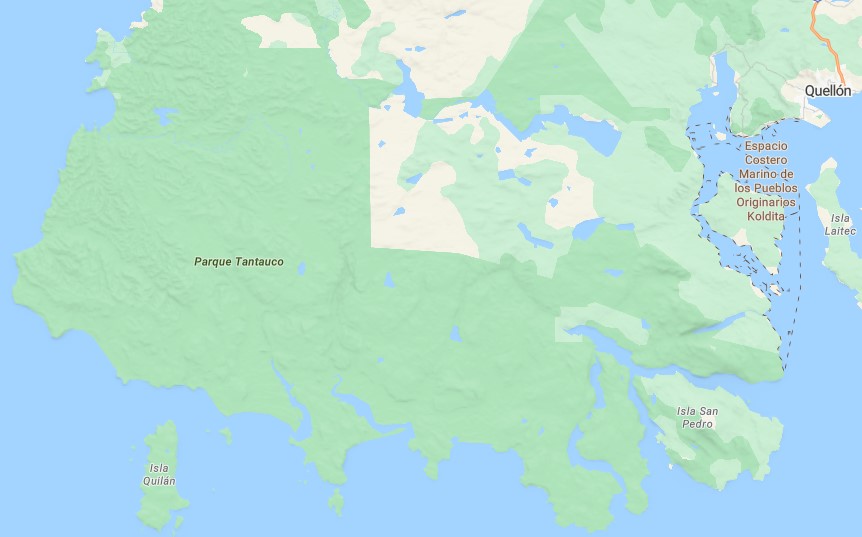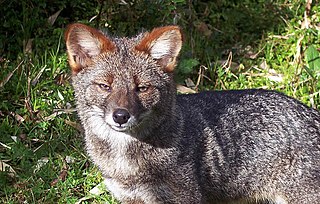Before heading to the parks further south, we’re going to take advantage of the easy and quick ferry connection from Chaitén to go west to the island of Chiloé. There we will loop through four astounding parks of a completely different biozone, and then eventually take the same ferry back to Chaitén.
To be most efficient, we’ll be starting from the southernmost park and then working our way north park by park, and then hopping on a bus back to Castro to get the ferry.
The first park you’ll encounter this way is Tantauco, which takes up the entire southwestern sector of the island, with exposure to both the Pacific Ocean and the Gulf of Corcovado, and from which you can see offshore the island of Quilán.
If you haven’t yet read up on some of the foundations of the entire seventeen-park route, go back and check out my overview post so you can get oriented.
Because Chaitén is highly sought out for various luxury treks and fishing expeditions, it is fortunate to have its own airport that has connections to Puerto Montt. This isn’t an international airport, however, so you can’t get here from anywhere else than from Puerto Montt. I’ll describe the prices and details in the Where to Start section later.
Even though Chaitén is getting down farther to the south of the Los Lagos region, the closest major airport hub to either it or Castro would still be Puerto Montt, as the next closest, Balmaceda, is almost twice the distance farther south.
In Puerto Montt, you can also reserve airport transfers to pick you up and take you to your hotel or to the bus station.
Tantauco is one of the few parks not managed by CONAF, so you won’t see the designation “Nacional” in its name. It is instead a huge conservation project maintained by a private foundation for public enjoyment.
The foundation has a broad range of services to help you get to and enjoy the park, including staying inside of it either through camping or lodges.
The basic entrance fee is USD $5 for any access point, and $1 for kids under 12 years and adults over 60 years of age.
Expand each of these services below to see their related fees so you can plan ahead on how much or little you want. Fees are different depending on which season you are visiting, so look for these initials:
To have SAB arrange any of these services, use our contact form to let us know your itinerary and what interests you.
Comfortably furnished domes or yurts are available for rent in the Chaiguata area. A yurt with a queen-sized bed for couples is USD $53(TB)/$63(TM)/$95(TA) per night. They also have family-sized yurts for about 25% more, and yurts for large groups that are 50% more. Each yurt has its own private bathroom with hot water, located outside the yurt.
Also in the Chaiguata area near the yurts there are twenty camping sites, each one with a shelter from the frequent rain squalls. There is also access to restrooms with hot water and a common area for larger meals and games.
In Inío, there are fifteen camping sites, common bathrooms with hot water, and a communal area for larger gatherings.
For either location, fees are USD $11 for a 2 person site per night TB and TM/$16 (TA), and $21 for a 3-4 person site per night TB and TM/$32 (TA).
On the southern fringe of the park where the the mouth of the river Inío runs into the Corcovado Bay, sits a beautiful beach house with individual rooms to rent. There are double rooms, three with private bathrooms and two with shared bathrooms, and two double rooms with private bathrooms.
On the second floor there are common areas and a fully equipped kitchenette for visitors to prepare their meals. It is recommended to reserve in advance since you will have to coordinate your trip with the park administration, especially in high season.
Rates range from USD $42 for a simple room with a shared bathroom in TB to $74 for a double-bed room with private bathroom in TA.
Deep into the forest hikes in the park are two maintained cabins for public rental. The first one is on Lake Chaiguaco that you can reach from the Chaiguata trail. Rates are per person and per night $11 (TB)/$16 (TM)/$21 (TA).
The second cabin is called Quilanlar and is a hike inland from Inio. Rates are $11 per person per night year round.
Tantauco administration will also rent you
Park fee included in all packages below.

You have two options where to start. The first is assuming you are following the route of parks in this series, and so you would already be on the eastern side of the Golfo Corcovado in the town of Chaitén. From there you would take the ferry, but not the one back to Puerto Montt. Instead, take the shorter five-hour ferry route that crosses the gulf to the town of Castro.
If, however, you are starting your itinerary to Tantauco or the Chiloé parks and won’t be in Chaitén, then the more sensible choice would be to fly in to Puerto Montt, the largest city of southern Chile. Or, read our article on how to get to Puerto Montt by bus from Santiago, which also describes some top attractions to check out when you get there.
To make it even more convenient, we have private drivers available to get you from and to the airport, or for full drives all throughout the Chiloé region.
I will be discussing all the transportation options in the Transportation Options section later in this article.


Open all year
Topography: Coastal Rainforest, marine coastal marshes and beaches
Climate: Rainy but mild
Chiloé in general is the less harsh side of Patagonia. It’s cloudy but bright, and has a kindness about it that makes you feel like you’re in the shire of Lord of the Rings, out of danger but still at the end of the world somewhere. I would characterize trekking in Chiloé as a healing venture as opposed to a challenging venture in other parts.
On top of that, Tantauco is the most remote and isolated you can get on Chiloé, so if you’re coming from Corcovado, then Tantauco is a good way to dial it back a bit and give yourself some contrast without too much of civilization re-entry.

Lastly, after you’ve been in the public CONAF forests for a while, it really is worth getting a taste of how the private foundation forests compare in their ecological conservation efforts as well as their care for visitors.
You’ll notice in this particular park the variety of tree species is all over the place, including Selva Valdiviana, Siempreverde or Selva de Chiloé, endangered species like Guaitecas Cypress and the Coastal Olivillo. Several parts of the park are still virgin forests that have never been subject to development.
As for the fauna, look for the Huillín river otter, the Chiloé Fox and Darwin’s frog (which is so endangered you have to disinfect your shoes if you get near their habitat to protect them from fungus you may bring in).
“Darwin” you ask? Yes, Charles Darwin spent a lot of time in Tantauco documenting new species like the frog, so his footprint is right on the same trails you’ll be exploring too.
|
Name
|
Distance
|
Hiking Time (round-trip)
|
Difficulty
|
Features
|
Open
|
|---|---|---|---|---|---|
|
Rio Yaldad
|
2.7 km
|
3 hours
|
Moderate
|
Forest
|
All year
|
|
Siempreverde
|
0.5 km
|
30 minutes
|
Easy
|
Forest, picnics
|
All year
|
|
Darwin
|
0.5 km
|
30 minutes
|
Easy
|
Lakeside, interpretive
|
All year
|
|
Bosque Hundido
|
2 km
|
2 hours
|
Easy
|
Forest and lake views, boardwalk
|
All year
|
|
Los Ñirres
|
5 km
|
3 hours
|
Moderate
|
waterfalls, suspension bridge, viewpoints
|
All year
|
|
Altos de Inío
|
6.4 km
|
4 hours
|
Moderate
|
birding, coastal views, primeval forest
|
All year
|
|
Punta Rocosa
|
4.5 km
|
3 hours
|
Easy
|
beaches, lighthouse, cavern
|
All year
|
|
Lago Chaiguaco
|
15.8 km
|
2 days
|
Moderate
|
lake, bogs, suspension bridge, cypher camp, river otters
|
All year
|
|
Quilanlar
|
22.4 km
|
2 days
|
Moderate
|
beaches, forests, viewpoints
|
All year
|
Since there is only one ferry per day from Chaitén that arrives in Castro in the late afternoon, I advise you to stay in town overnight and then head to Tantauco in the morning. In truth, it’s only three hours south of Castro to the Chaiguata entrance of Tantauco, but options to get there at night are non-existent. Even options in the daytime have to be carefully timed as they are few and you want to maximize use of your daylight hours.
If you’re coming from Puerto Montt, I would still not advise trying to get to the park in one day. Stay in Castro as a halfway stop, stroll around town for the afternoon, and then head to Tantauco the next morning.
Transportation south of Castro to the park from March to the end of December is only available through private transfers, tour operators, or the park’s own tour packages that include a transportation service (the Transversal Deluxe or Tantauco Deluxe packages detailed above in the Permits and Fees section). Only in January and February, the high season, is there a regular bus from Castro to the park, which operates only on Tuesdays every week.
So the best and most economical public strategy is to plan a visit to the Tantauco where you arrive in Castro on a Monday in January or February and take the bus to Tantauco the next morning, Tuesday.
If you’re going to stay in the park only for a day, then you can take the bus back to Castro on the same Tuesday. If you’re staying for more than one day, you’ll either need to stay a week or arrange for private transportation to pick you up.
If you’re interested more in accessing the park at the southern end, Caleta Inío, and hiking the trails there, your strategy can be one of two:
I’ll go more into the details of each transportation option now.
You can get an online reservation aboard the ferry from Chaitén to Castro. Departures are at 11:00 am daily for a trip of five hours across the bay.
From there, it depends on which part of the park you want to reach. For the northern entrances (Chaiguata, Yaldad), see the By bus from Castro to Northern Entrances, or Private shuttles. If you are headed to the southern entrance, see the section By bus from Castro to Southern Entrance or By plane.
The bus from Castro to Tantauco only operates on Tuesdays during the months of January and February. They go back and forth throughout the day, but the exact schedule varies every year as well as the boarding point. So it’s best to ask your hotel about the latest bus schedule for this special route. No reservations are necessary for this bus line.
The bus drops at both the Yaldad entrance, and then farther in at the Chaiguata entrance. You can get back on the bus at either of these places, again only on Tuesdays.
There are a generous amount of bus departures from Castro to Quellon that you can reserve online, which is about a 90 minute trip. You can even find a departure that departs after the ferry arrives from Chaitén, and you can be in Quellon to spend the night there.
The buses drop just a block from the pier, which is where you’ll transfer on to the commuter boat that takes passengers from Quellon to Caleta Inio, the southern access to park Tantauco.
The boat pier is located at the intersection of Gomez Garcia and Costanera Pedro Montt. However, the departures are only on Sundays and Wednesdays at 12:00 pm (noon), so make sure you’re arriving to Quellon from Castro on a Saturday or Tuesday, sleep overnight in Quellon, and then board the boat the next day. Return trips on the boat are only on Mondays and Thursdays at 8:00 a.m. No reservations are needed.
The airport is a small affair in the village of Gamboa on the outskirts of Castro. There are no regularly scheduled flights, but they are accustomed to tourists requesting to fly to the Inio airstrip. This is a forty-minute flight on a small craft.
There are no flights to the anywhere else in the park except the Inio airstrip at the southern end.
If you are interested in the plane option and would like to inquire about availability and prices, please use our contact form to share with us your exact itinerary.
Buses from Puerto Montt are available any day for trips to Castro (4 hours) or to Quellon (6 hours), and seats can be reserved online.
Once you have arrived, follow the instructions stated in any of the previous transportation sections to continue your journey to the park.
You also have the option of hiring private transportation to take you directly from Castro to the Tantauco northern park entrance (Chaiguata). They take you in 4×4 vehicles because part of the route is rough (which is why the bus only does this in the best weather months).
By all means, try to make your travel to Tantauco in the months of January or February if possible, as that’s the time of year not only when the weather is at its best, but you have the widest variety of transportation options ready to serve.
If you are going at another time of year, it really depends on how tight your schedule is and where you want to go in the park. My personal favorite is the southern side of the park, which is the hardest to get to, but when you consider they have a beautiful guest house there, a small museum, and one of the best-rated trails in all of South America (the Caleta trail on the beaches, and the lighthouse), it’s really worth it and not that expensive. Even the plane option is going to be less than $100 USD.
South America Buses (SAB) is the luxury channel of AndesTransit, the land travel transportation schedule and reservation hub preferred most by travelers to Latin America. SAB has a select team of distinguished travel experts who have dedicated themselves to research, document, and curate routes and carriers in South America that meet nothing short of the highest quality standards in land travel.
Other Links
Copyright © 2024 SouthAmericaBuses. All rights reserved.
